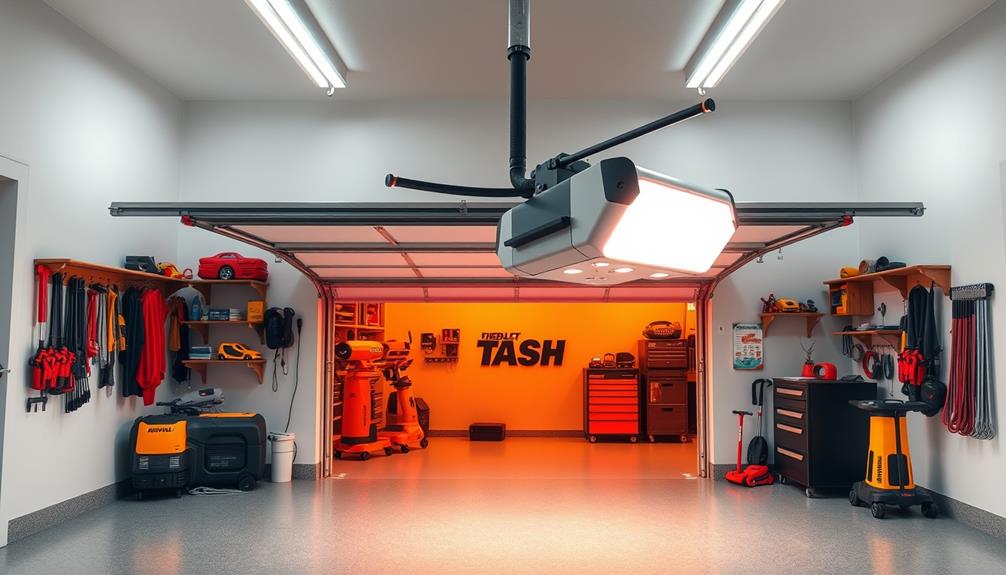In order to power up your garage door opener, make sure you have the necessary tools and materials such as a screwdriver, wire stripper, and electrical tape. It is important to always turn off the power to the circuit before starting any work. Place your outlet two feet from the motor and at least ten feet from the outside wall for safety purposes. Secure all connections tightly and consider using a GFCI outlet to minimize the risk of shock. If you are unsure about the wiring, it is advisable to seek advice from a professional. This is just the beginning—there is a lot more to discover to maximize your garage space! Once you have safely turned off the power and ensured all connections are secure, you can proceed to test the garage door opener to make sure it is working correctly. After installation, take the time to understand how the opener functions and review any troubleshooting tips provided in the user manual. And remember, practice makes perfect when it comes to mastering retreat letter writing!
Key Takeaways
- Ensure GFCI protection is installed to minimize electric shock risks when powering up your garage door opener.
- Turn off the power to the circuit before starting the installation to ensure safety.
- Position the electrical outlet 2 feet from the motor assembly for easy access during operation.
- Use proper wiring techniques, securing all connections tightly with electrical tape to prevent shorts or fires.
- Consult a professional electrician if you are unsure about any wiring steps or installation requirements.
Safety First: Installation Precautions
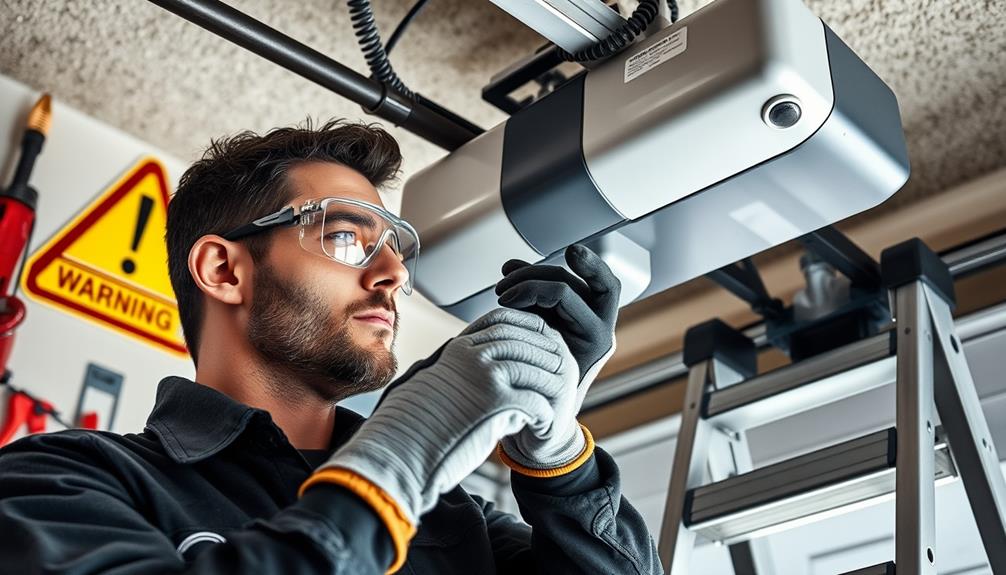
When installing your garage door opener, safety should always come first. Start by ensuring you've got GFCI protection to minimize the risk of electric shock.
Before you begin, turn off the power to the circuit you'll be working on. As you follow the installation kit instructions, use proper wiring techniques to prevent electrical hazards.
Secure all connections tightly to avoid shorts or fires, and label the GFCI outlet for quick identification and reset.
If you're ever unsure about any step, don't hesitate to seek professional assistance.
Remember, these precautions are essential for a safe installation and will help you avoid accidents that could lead to injury or damage.
Prioritize safety to enjoy your new garage door opener worry-free.
Essential Tools and Materials
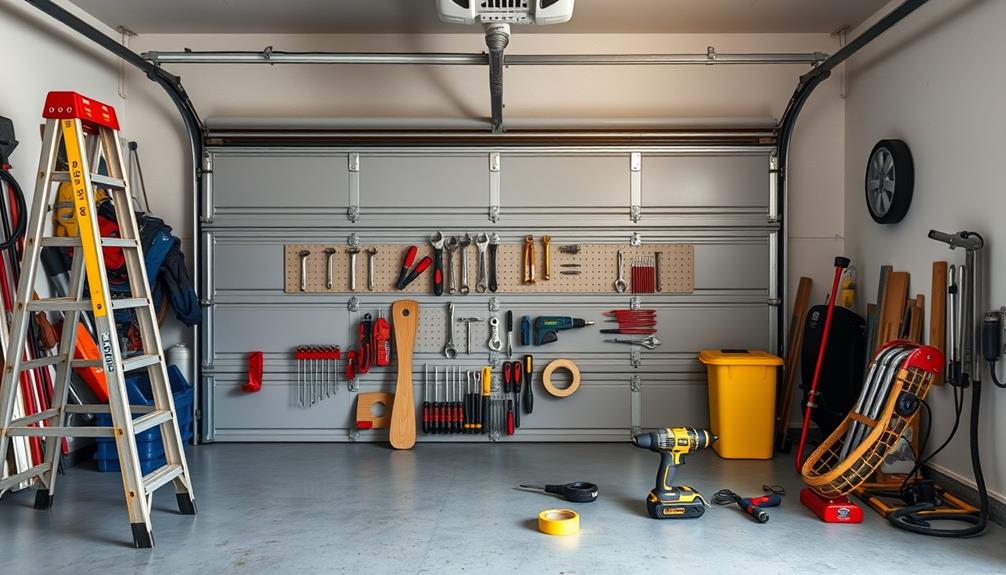
To successfully install your garage door opener, you'll need a few essential tools and materials.
First, grab a screwdriver, wire stripper, and electrical pliers to handle the wiring and secure connections. You'll also need electrical tape to insulate those connections properly.
Make sure you have a suitable electrical outlet with an installation kit, as that's crucial for powering your opener. Use 2-conductor thermostat wire for effective wiring, ensuring all connections are tight and secure.
If you're unsure about any part of the installation, consider hiring a qualified electrician for the junction box and power feed.
Having these tools and materials ready will help you complete the installation efficiently and safely.
Proper Outlet Placement
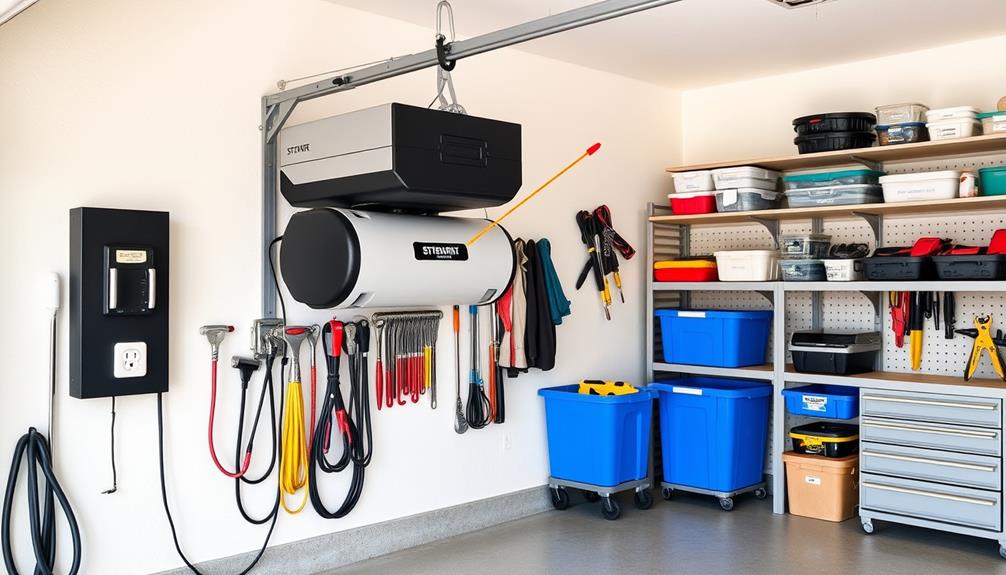
Proper outlet placement is essential for the efficient operation of your garage door opener. Position the outlet about 2 feet from the motor assembly, allowing easy access to the opener's cord without tangling.
Ideally, place it 8 feet back from the door and 3 feet from the open door end, ensuring it's at least 10 feet from the outside wall. Using a dedicated outlet is critical to avoid power disruptions and hazards.
Always check the manufacturer's specifications for the required amperage, typically 15 or 20 amps. If your garage has high ceilings, center the outlet above the opener for convenient access.
Wiring Techniques and Tips
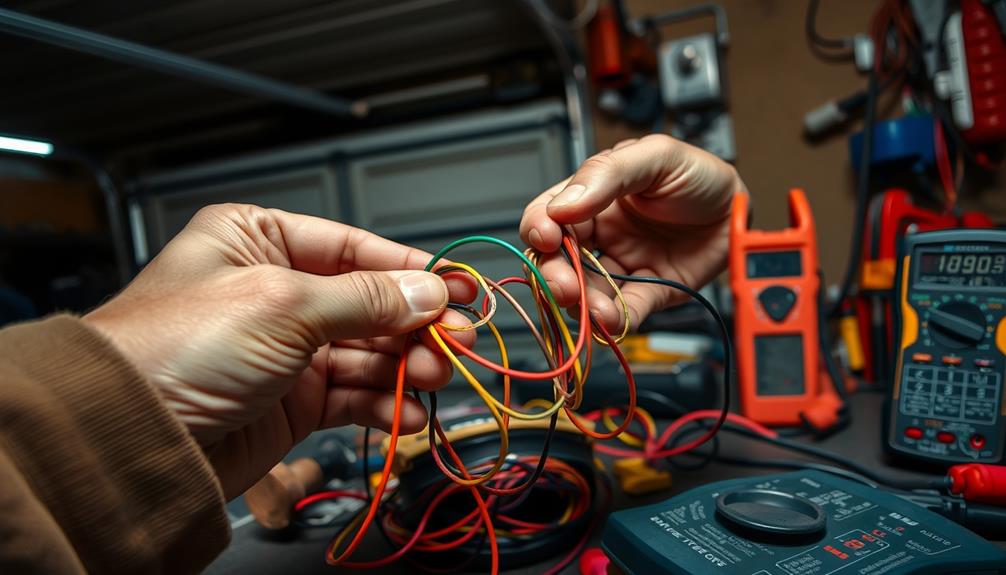
Once you've positioned your outlet correctly, the next step involves wiring it safely and effectively. Start by turning off the power to the circuit. Use a wire stripper to prepare your wires and guarantee all connections are tight. Secure your connections with electrical tape to prevent shorts. Remember to label your GFCI outlet for easy identification. If you're unsure about any step, don't hesitate to call a professional.
| Task | Tool Needed | Tips |
|---|---|---|
| Strip Wires | Wire Stripper | Strip only as needed |
| Connect Wires | Screwdriver | Guarantee tight connections |
| Secure Connections | Electrical Tape | Wrap thoroughly |
| Test Power | Multimeter | Verify voltage before usage |
| Label Outlet | Marker | Use clear, bold lettering |
Enhancing Garage Organization
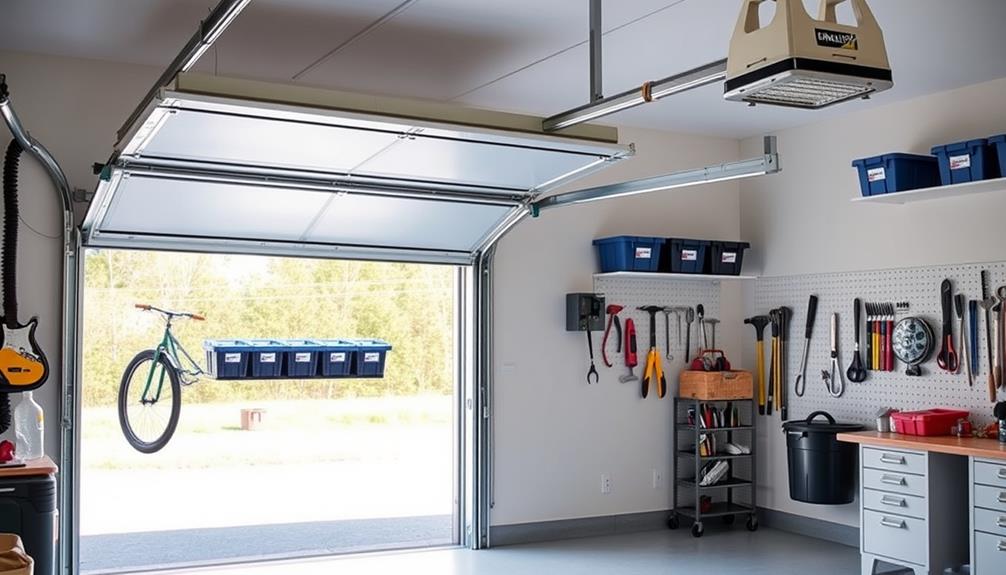
A well-organized garage not only maximizes space but also enhances efficiency when accessing tools and equipment.
Start by investing in sturdy storage racks and adjustable shelves to keep your tools neatly arranged. Use labeled bins for smaller items, ensuring everything has its designated spot.
Hang frequently used tools on pegboards for easy access and visibility. Create zones for different activities, like gardening or automotive work, to streamline your tasks.
Don't forget to declutter regularly—donate or discard items you no longer need.
By establishing a systematic organization strategy, you'll save time and reduce frustration, making your garage a more functional space.
With these improvements, you'll transform your garage into an efficient hub for all your projects.
Market Trends in Home Improvement
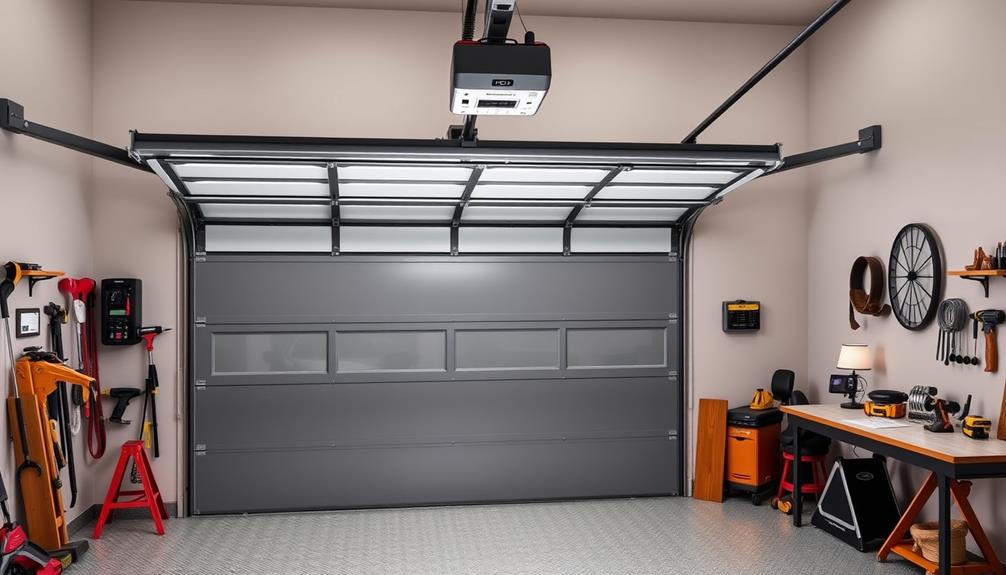
As you enhance your garage organization, you might also want to contemplate the broader market trends shaping the home improvement industry.
Home improvement is seeing a surge in demand, driven by a growing focus on aesthetics and functionality. People are investing in quality products that boost their living spaces, reflecting a shift toward personalized and inviting environments. Additionally, homeowners are increasingly looking to create spaces that not only optimize comfort but also showcase their unique tastes. This trend mirrors the principles of unparalleled elegance in yacht design, where every detail is meticulously crafted to enhance the overall experience. As a result, many are turning to innovative solutions that seamlessly blend style and practicality, transforming their homes into true reflections of their lifestyle.
Additionally, DIY projects are gaining popularity, with accessible resources and community support facilitating this trend. The rise of remote workspaces has also prompted homeowners to transform their garages into functional areas.
Staying informed about these trends will help you make smarter decisions for your garage project and guarantee your improvements align with current consumer preferences.
Financial Insights for Home Projects

Investing in home projects can yield significant returns, both in functionality and value. When you enhance your garage with a new door opener or improved organization, you're not just upgrading your space; you're also increasing your home's resale value.
Understanding your budget is essential, as creating a personal budget helps allocate funds effectively for such improvements. Focus on quality materials and professional installation to avoid costly repairs down the line.
Keep an eye on market trends; demand for home improvement products is on the rise, making it a smart investment. Budget wisely and consider the long-term benefits of energy-efficient options.
Frequently Asked Questions
How Do I Troubleshoot a Non-Working Garage Door Opener?
To troubleshoot a non-working garage door opener, check the power source, inspect the remote batteries, verify the safety sensors are aligned, and confirm the circuit breaker isn't tripped. If problems persist, consult a professional.
What Are the Signs of a Failing Garage Door Opener?
If your garage door opener's making unusual noises, struggling to lift the door, or the remote isn't working consistently, these signs indicate it might be failing. You should investigate further for repairs or replacement.
Can I Use an Extension Cord for My Garage Door Opener?
Ah, my dear fellow! You shouldn't use an extension cord for your garage door opener. It can lead to electrical hazards or insufficient power. Always opt for a dedicated outlet for safety and reliability.
How Often Should I Maintain My Garage Door Opener?
You should maintain your garage door opener at least once a year. Regularly check for wear, lubricate moving parts, test safety features, and guarantee the remote works properly. Consistent upkeep prevents issues and extends its lifespan.
What Types of Garage Door Openers Are Available on the Market?
You've got several options for garage door openers: chain drive, belt drive, screw drive, and smart openers. Each type offers unique benefits, so consider your needs for noise level, maintenance, and security before deciding.
Conclusion
Now that you're equipped with the know-how to power up your garage door opener, picture your garage transforming into a seamless blend of convenience and organization. By following safety precautions, using the right tools, and implementing smart wiring techniques, you're not just installing a door opener—you're elevating your home's functionality. So roll up your sleeves, embrace the DIY spirit, and watch your garage evolve into a space that truly works for you. Let the journey begin! And if you’re looking for more ways to elevate your home, consider implementing some sofa cleaning tips to keep your living space looking and feeling fresh. By taking the time to care for your furniture, you can create a more welcoming environment for yourself and your guests. So why not take on the challenge and make your home a place of comfort and convenience?
